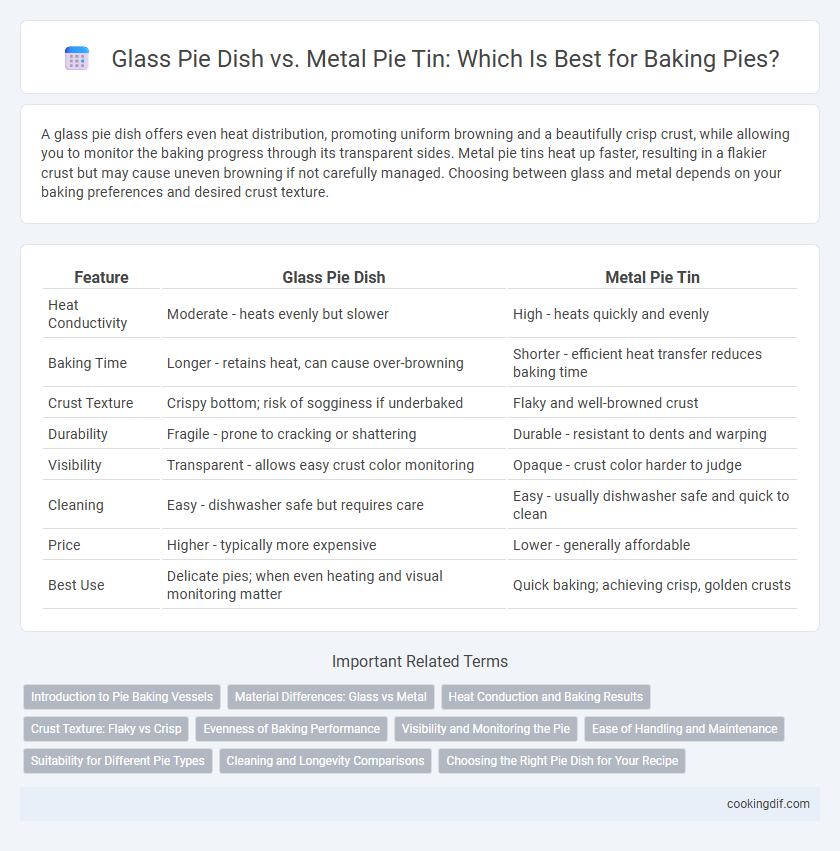A glass pie dish offers even heat distribution, promoting uniform browning and a beautifully crisp crust, while allowing you to monitor the baking progress through its transparent sides. Metal pie tins heat up faster, resulting in a flakier crust but may cause uneven browning if not carefully managed. Choosing between glass and metal depends on your baking preferences and desired crust texture.
Table of Comparison
| Feature | Glass Pie Dish | Metal Pie Tin |
|---|---|---|
| Heat Conductivity | Moderate - heats evenly but slower | High - heats quickly and evenly |
| Baking Time | Longer - retains heat, can cause over-browning | Shorter - efficient heat transfer reduces baking time |
| Crust Texture | Crispy bottom; risk of sogginess if underbaked | Flaky and well-browned crust |
| Durability | Fragile - prone to cracking or shattering | Durable - resistant to dents and warping |
| Visibility | Transparent - allows easy crust color monitoring | Opaque - crust color harder to judge |
| Cleaning | Easy - dishwasher safe but requires care | Easy - usually dishwasher safe and quick to clean |
| Price | Higher - typically more expensive | Lower - generally affordable |
| Best Use | Delicate pies; when even heating and visual monitoring matter | Quick baking; achieving crisp, golden crusts |
Introduction to Pie Baking Vessels
Glass pie dishes provide even heat distribution that helps achieve a uniformly baked crust and allow bakers to monitor the browning process through the transparent sides. Metal pie tins, especially those made of aluminum, heat up quickly and produce a crispier, golden crust, but they require careful temperature control to prevent over-browning. Choosing between glass and metal pie vessels depends on the desired crust texture and baking precision for different pie recipes.
Material Differences: Glass vs Metal
Glass pie dishes offer even heat distribution and retain heat longer, resulting in a uniformly baked crust with a golden finish. Metal pie tins, often made from aluminum or tin, heat up faster and produce a crisper, well-browned bottom due to better conduction. The non-reactive nature of glass prevents any metallic taste, while metal tins excel in delivering quick baking times and sharper crust edges.
Heat Conduction and Baking Results
Glass pie dishes provide even heat distribution, reducing the risk of hot spots and ensuring a uniformly baked crust, while metal pie tins offer superior heat conduction that promotes a crispier, browner crust. The slower heat absorption of glass allows for gradual baking, ideal for delicate fillings, whereas metal's rapid heat transfer accelerates crust browning but can lead to quicker edges. Choosing between glass and metal depends on the desired crust texture and baking precision for the pie recipe.
Crust Texture: Flaky vs Crisp
Glass pie dishes retain heat evenly and promote slower baking, resulting in a flakier crust with tender layers. Metal pie tins heat up quickly and provide better heat conduction, creating a crisper, more browned crust. Choosing glass or metal baking vessels can significantly impact the texture of the pie crust, with glass favoring flakiness and metal enhancing crispness.
Evenness of Baking Performance
Glass pie dishes provide even heat distribution, promoting consistent baking and preventing hot spots that can cause uneven crust browning. Metal pie tins conduct heat more rapidly, which can result in crispier crusts but may increase the risk of over-baking or burnt edges. For uniform baking results, glass dishes offer more controlled and steady heat, while metal tins excel in producing a crisper finish.
Visibility and Monitoring the Pie
A glass pie dish allows clear visibility, enabling bakers to monitor crust browning and filling bubbling without opening the oven, ensuring precise baking. Metal pie tins conduct heat more efficiently but lack transparency, making it harder to gauge doneness visually. Choosing glass improves the ability to track pie progress, reducing the risk of overbaking or underbaking.
Ease of Handling and Maintenance
Glass pie dishes offer clear visibility during baking and tend to be heavier, providing stability but requiring careful handling to avoid breakage. Metal pie tins heat up quickly and are lightweight, making them easy to maneuver but prone to warping and rust if not properly maintained. Cleaning glass dishes is simpler due to their non-porous surface, whereas metal tins often need thorough drying to prevent corrosion and may require seasoning for longevity.
Suitability for Different Pie Types
Glass pie dishes offer even heat distribution and are ideal for fruit pies and custard-based pies, as they help achieve a golden, evenly baked crust while allowing easy visual monitoring of browning. Metal pie tins heat up quickly and provide a crisper, flakier crust, making them preferable for meat pies and savory types where a well-defined crust texture is essential. Choosing between glass and metal depends on the desired crust outcome and pie filling sensitivity to temperature changes.
Cleaning and Longevity Comparisons
Glass pie dishes are non-porous, making them easier to clean and resistant to staining or retaining odors, which enhances their longevity compared to metal pie tins that can corrode or develop rust over time. Metal pie tins, while lightweight and conductive, often require thorough drying to prevent rust and may show wear and discoloration after repeated use. Choosing a glass pie dish ensures durability and simpler maintenance, as it withstands frequent washing without degrading, unlike metal options that may need gentle care to extend their lifespan.
Choosing the Right Pie Dish for Your Recipe
Glass pie dishes offer even heat distribution and allow bakers to monitor crust browning easily, making them ideal for recipes requiring precise baking times. Metal pie tins heat up quickly and produce crispier crusts, perfect for fruit pies and quiches needing high-temperature baking. Selecting between glass and metal depends on desired crust texture and recipe-specific heat conduction needs.
Glass pie dish vs metal pie tin for baking vessel Infographic

 cookingdif.com
cookingdif.com